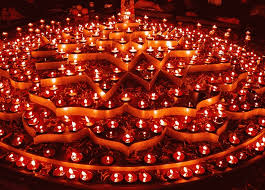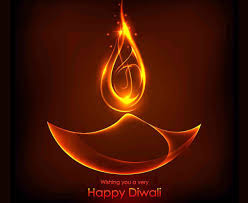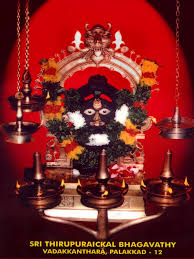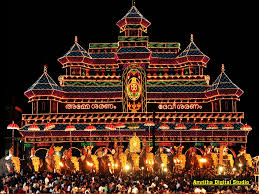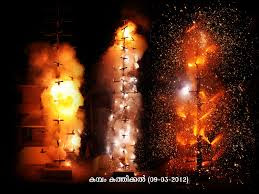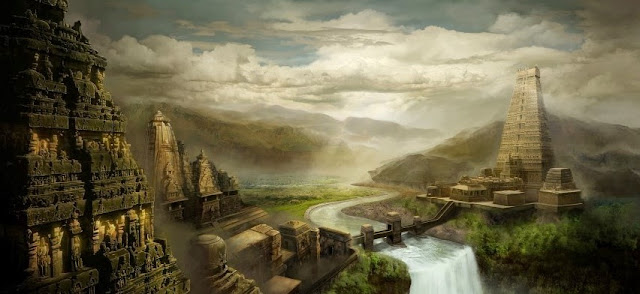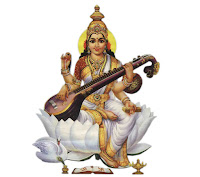Yaa Kundendu tushaara haara dhavalaa, Yaa shubhravastraavritha|
Yaa veena vara dandamanditakara, Yaa shwetha padmaasana||
Yaa brahmaachyutha shankara prabhritibhir Devaisadaa Vanditha|
Saa Maam Paatu Saraswatee Bhagavatee Nihshesha jaadyaapahaa||
Saraswati is the Hindu goddess of knowledge, music, arts, wisdom and learning. She is a part of the trinity (Tridevi) of Saraswati, Lakshmi and Parvati. The goddess Saraswati is often depicted as a beautiful woman dressed in pure white, often seated on a white lotus, which symbolizes light, knowledge and truth. She not only embodies knowledge but also the experience of the highest reality. Her iconography is typically in white themes from dress to flowers to swan – the colour symbolizing Sattwa Guna or purity, discrimination for true knowledge, insight and wisdom.
She is generally shown to have four arms, but sometimes just two. When shown with four hands, those hands symbolically mirror her husband Brahma's four heads, representing manas (mind, sense), buddhi (intellect, reasoning), chitta (imagination, creativity) and ahamkāra (self consciousness, ego).Brahma represents the abstract, she, action and reality.
The four hands hold items with symbolic meaning — a pustaka (book or script), a japa mala (rosary, garland), a water pot and a musical instrument,Veena. The book she holds symbolizes the Vedas representing the universal, divine, eternal, and true knowledge as well as all forms of learning. A mālā of crystals, representing the power of meditation, inner reflection and spirituality. A pot of water represents the purifying power to separate right from wrong, the clean from the unclean, and essence from the inessential. In some texts, the pot of water is symbolism for soma - the drink that liberates and leads to knowledge. The most famous feature on Saraswati is a musical instrument called a veena, represents all creative arts and sciences,and her holding it symbolizes expressing knowledge that creates harmony. A hamsa or swan is often located next to her feet. In Hindu mythology, the hamsa is a sacred bird, which if offered a mixture of milk and water, is said to be able to drink the milk alone. It thus symbolizes the ability to discriminate between good and evil, essence from outward show and the eternal from the evanescent. Due to her association with the swan, Saraswati is also referred to as Hamsavāhini, which means "she who has a hamsa as her vehicle". The swan is also a symbolism for spiritual perfection, transcendence and moksha.Sometimes a citramekhala (also called mayura, peacock) is shown beside the goddess. The peacock symbolizes colorful splendor, celebration of dance, and - as the devourer of snakes - the alchemical ability to transmute the serpent poison of self into the radiant plumage of enlightenment. She is usually depicted near a flowing river or other body of water, which depiction may constitute a reference to her early history as a river goddess.
As we are approaching the Saraswathi pooja festival this year, let's have a look at the major Saraswathi temples in Kerala. The list is incomplete, hence the readers are requested to contribute any valuable information.
Here is a district-wise listing of Saraswathi temples in Kerala:
Thiruvananthapuram
1. Varkkala Shivagiri Sarada Temple:
-------------------------------------------------
Address: Sivagiri Rd, Varkala, Kerala 695145
Phone: 0470 260 2807
Shivagiri is a pilgrimage centre in Varkala, Thiruvananthapuram where Sree Narayana Guru's tomb is located and place where guru was enlightend and got the salvation. After travelling many places in South India and Sri Lanka and establishing temples, he did the prathishta of the goddess Sree Sarada at Sivagiri on April 1912. It ranks as the most remarkable among his consecration of temple deities, and occupies a distinguished place in history. Foundation for it had been laid in 1909. The same year he composed the poem "jananee navarathna manjari".
Sivagiri Sarada Mutt was planned and designed by Gurudevan who took a particular interest in it. Ordinary temples do not have windows. Gurudevan called this temple, which is octagonal in shape, 'Sarada Mutt. Here unlike in other temples, there is no nivedyam (offering of food to the deity) or abhishekam (pouring oil, ghee and such on the idol). Devotees can worship the goddess by reciting hymns. The idol of Saraswathy seated on white lotus is the symbol of knowledge blossoming on whiteness or purity.The Sarada Consecration Committee had Dr.P.Palpu as its president and Kumaran Asan was secretary.
2.Venkulam Saraswathi Temple Edava Varkkala
3.Vattiyoorkkavu Arappura Eswari Amman Saraswathi Temple
Address: Vattiyoorkkav-Arappura Rd, Vattiyoorkavu, Thiruvananthapuram, Kerala 695013
Phone: 094477 47273
Kollam:
1.Changankulangara Sarada Temple, Ochira
2.Ezhukon Mookambika Temple
Alappuzha:
1.Thattarambalam Saraswathi Temple
Thattarambalam Saraswathi Temple is situated at Thattarambalam junction near Mavelikkara (2 Km west of Mavelikkara) in Alappuzha district. This temple is managed by
Travancore Devaswom Board. Thattarambalam temple is more than 1000 years old and the Unnuneeli Sandesam of 14th century mentions about this temple. History says that the King of “Odandu” built this temple in his capitol place and is made especially for the Goldsmiths he brought from Tamil Nadu. Later on, administration of this temple is handed over to Travancore Dewaswam Department as the kingdom Odanadu is merged to Travencore.
The main festival of the temple is “Navarathry”. Thiruvonam of Chingam, Vishu, Makarasamkramam, Vinayaka Chathurthy, Sivarathri and Mandalakalam are the other important festivals of the temple. This is the only Saraswathi Temple in Kerala having Navagraha Prathishta. Shiva, Ganapathy and Sastha are the upadevathas. The famous Kandiyoor Mahadeva Temple and Chettikulangara Devi Temple are near to this temple.
To reach Thattarambalam
Thiruvalla/Chengannur-Mavelikkara-Kandiyoor-Thattarambalam-Chettikulangara-Kayamkulam
or
Ambalappuzha/Harippad-Nangyarkulangara- Thattarambalam- Mavelikkara
For more details visit http://thattarambalamtemple.com/
2.Eramalloor Saraswathi temple
Address: Eramalloor, Ezhupunna, Kerala 688537
Phone: 096560 38181
Kottayam:
1. Panachikkad Dakshina Mookambika Saraswathi Temple Kottayam
-------------------------------------------------------------------------------------------
Eravinalloor Panachikkad Temple Rd, Panachikkad, Kerala 686533
Phone: 0481 233 0670
The Saraswathi temple in the Panachikadu village of Kottayam district, Kerala is known as Dakshina (Southern) Mookambi. Eventhough many Saraswathi temples perform pooja only during the ' Navarathri period', this temple offers pooja throughout giving ' darshan' to the devotees.
This temple is situated in the panachikadu village 11 kilometers away from the well known Kottayam District Head Quarters of South Kerala. This village resembles the famous Kodajadri,. In the Main Central Road( MC Road), between Kottayam and Changanassery, there is a small village called Chingavanam. Travelling 4 kilometers east fromChangavanam one can reach the temple situated in an idyllic and beautiful place.When we reach the precincts of the temple we see first a “Vishnu temple “.just a few metres south of the Vishnu shrine we can see the ‘saraswathy temple’ in a natural valley with the water dripping and flowing around the idol. The temple does not have the traditional sanctum sanctorum and other pompous structures of the temples elsewhere. There is a rectangular pond like structure as though it has been caved out of a granite hillock. In this pond there grows lush green creeper plants of exquisite beauty. Covered by the creeper the original ‘idol’ of saraswathy remains. Near the original idol of “devi saraswathy”there is another alternate idol on which all the poojas are performed.
Two things specially to be noticed here are the creepers and the immaculate spring. The leaves of the creepers which cover the idol are considered saraswathy leaves. The water comes from the spring here flows touching the feet of the “Devi” never dries even in the peak time of summer. Since the devi remains on such a “Saras” (small rivulet) the name saraswathy becomes meaningful. The water required for poojas and other needs are taken from the spring. No well or other water sources are available here.
Above the saraswathy temple on the western side there is a natural habitat made of exotic plants and their fragrant flowers. Here lives the ‘yakshi’ who is at once fastidious and easily made happy. The idol of ‘brahmarakshasu’ is also installed here. Eventhough there are yakshi shrines in other temples, as well, the power of the yakshi at panachikadu seem to be super. In addition there are idol of Siva, Sastha, Ganapathi, Nagayakshi, Nagaraja and the like sub deities too here.
In the ‘lthihyamala’of kottarathil sankunni there is a detailed description of this temple-this temple having more than one thousand years of history, there are three Brahmin families, kizhupuram,Karunad and kaimukku,asits traditional care takers. From among these illams a respectful Brahmin from the kizhupurathillam disappointed by not getting a male child, took up a journey to Ganges to take holy bath. On the way reaching mookambika he stayed there for a few days praying to the deity there. One day the devi appeared before him and advised him to go back to his native place. She told him that a nampoothiri lady of Karunattillam is now pregnant and that she will deliver two children. One of the children be adopted by him as his own and bring him up. As directed by the devi the next day the devotee took bath, worshipped the devi and returned to his house. In his palm leaf umbrella there was Devi’s blessing and power. When he reached Panachikad,the palm umbrella become stiff without any movement. then holy Godman appeared before him and pronounced that there is devi’s power and blessings in the umbrella. He advised the Brahmin to do poojas and the power of saraswathy be installed in a temple at Panachikadu. An idol which was lying deserted there was seen. The Brahmin was told to incarnate the power of the devi in this old idol which was worshipped by Godman with supernatural power long time ago. Since such Godmen with supernatural powers are not available now an alternate idol was installed in Panachikad.
Even today in the temple of the care takers traditional rituals and poojas are performed as of then. The order in which Pooja performed to Mahavishnu, sarawathy,
Ganapathy, Siva, Sastha,Yakshii, and Nagaraja. Like the Ganges which touches the feet of Vishnu it is form the feet of Vishnu that the holy water flows to the shrine of Saraswathi.
From various parts of India devotees come here for ‘Darshan’ Irrespective of religions people come here for ‘Vidyarambham’ (the ceremony of beginning education). Except on the days of ‘Durgashtami’ and ‘Mahanavami’ all other days ‘Vidyarambham’ is performed here. The ghee enriched with; Saraswatha Manthram’ is distributed to devotees from here.The intake of this ghee enriches the intelligence of children for intelligence and education this is considered very good. For saraswathy and Vishnu, yakshi, Rakshas ,
2. Sreepuram Saraswathi Temple - Parippu, Kottayam
------------------------------------------------------------------------
Sree puram Saraswathi, temple is situated at 9 Kilometers away from Kottayam Town,near the bank of beautiful Meenachil River.Temple is now governed by Travancore Devaswam Board.
There is two Bhava’s at the temple Shrine. One is Godess Madhurai Meenakshi and the other is Vidyadevatha Sri.Saraswathi. During Karkidakam (July Auguest months) Bhagavathi Seva is performing every day. Special pooja’s are conducting during the Mandalamasam (Vrischigam to Makaram)There is a Nagaraja Prathishta also near this temple.
When the Navarathry season comes,The Kuriyannoor and Chenappady family members jointly doing special poojas throughout the day in 9 days with the help of Khsetra Upadesaka samathy and all the people around Parippu.and Kottayam.Durgashtami,Manavami and Vijayadashami are most important and on these days Music concerts are also performed.On Vijayadashami day many young kids are coming to start” Harishri” from this Saraswathi temple.
If any body like to visit or doing any special prayers at this temple,please contact at the below said address.
K.Ananda Ram,Geethanjali,Parippu.P.O,Kottayam-14
Mob.9447660792, Ph.0481-2516486
anandangeethanjali@gmail.com or anandangeethanjali@yahoo.in
3. cheruvalli Uma Saraswathi temple
Eranakulam:
1.Dakshina Mookambika Temple, north Paravoor
----------------------------------------------------------------
The Sub-group Officer,
Dakshina Mookambika Temple
N. Paravur, Ernakulam Dist. ,
Kerala - 683513
E-mail: dhakshinamookambika@hotmail.com
dhakshinamookambika@yahoo.com
The Dakshina Mookambika Temple is a famous Saraswati temple in the town of North Paravur in the Ernakulam district of Kerala. The presiding deity in this temple is Saraswati and sub-deities are Ganapathy, Subrahmanyan, Mahavishnu, Yakshi, Hanuman and Veerabhadran. A shrine devoted to Yakshi is at the southwest corner. The sanctum sanctorum is in the midst of a lotus pool.
According to legends, Thampuran (ruler) of Paravur was a great devotee of Goddess Mookambika. He used to visit the Kollur temple in Mangalore every year to pay homage to the goddess. When he became old, his health worsened and he could no longer undertake the long journey to Kollur. The goddess appeared to the sad devotee in a dream and ordered him to build her idol near his palace so that he can have daily darshan of her. Thampuran followed her instructions, built a temple at Paravur and installed the Goddess.
The famous Navratri festival is celebrated here with great fervor. Thousands of people participate in the Navaratri music festival. On Durgashtami, books are arranged before the image of Goddess Saraswathy and on Vijayadashami morning, Ezhuthinirithu or Vidyarambham ceremony takes place at a special mandapam which goes from 4 am to 11 am. Thousands of little children are initiated into the world of letters by making them write the word harisree on rice, their tongues or sand with a golden ring.
Apart from the Navratri festival, the "ten-day annual festival" is celebrated in the month of Makaram (January–February). The music festival and Vidyarambham ceremony are the main features of this festival.
The presiding deity in the sanctum sanctorum of Dakshina Mookambika temple at N.Paravur is Bala Parameswari, the daughter of Lalitha Parameswari. she showed her bravery in the battle with Bhandasura who was born out of the ashes of Kamadeva. Lalitha Parameswari who is the mother of Bala Parameswari emerged from the fire (Chidagnikunda), When the Devas headed by Indra worshiped the goddess for getting protection from Bhandasura. Lalitha Parameswari in her Chariot, Sree Chakra moved for the battle and she was assisted by Mathangi (Manthrini) and Varahi (Dandanatha). Mahaganapathi was also born when the vighnayanthra stopped the movement of the soldiers and he threw the Yenthra so as to proceed in the battle (Kameswari- Lalitha came face to face with Kameswara-Siva; this union gave birth to Mahaganapathi).
Bala Parameswari is the basic upasana devatha in order to have access to Lalitha parameswari having shodasa kalas of a full moon. The initiation to the Bala Manthra is quite essential to fulfill the Sree Vidya Sadhana and to enjoy the ecstasy that enthrals us in the spiritual acme. Such a powerful Devatha is installed here at Dakshina Mookambika Temple. The Japamala (rosary), the veda and abhayavarada are signs of wisdom and knowledge that lead to fearlessness. The Kashaya Nivedyam during the Atthazha Pooja (at 7.30 pm) daily is a precious medicine that cures all the problems physical, phychological and intellectual. The three syllable manthra when chanted, we become enchanted to the realm of supreme spiritual attainment. But the people are quite ignorant of all these valuable secrets now. The temple and the approach to it are occult in its nature since there is thanthra in the installation process.
The very sanctum sanctorum erected in the centre of a tank where the lotus blooms, is the abode of Bala Parameswari. The lotus is symbolic and its sanctity is precious; when the sun begins to shine the petals are opened indicating the sahasrarapadma, the very brain that should bloom like the lotus in the presence of spiritual light.
The parivara devathas that are installed include mainly Ganapathi inside, Ganapathi outside, Muruga- the jnana devatha, Vishnu the preserver of the universe. Among the parivaras Hanuman the powerful deity both Saiva and Vaishnava, Veerabhadra Lord Siva himself are also there to bless us.
2. Avanamcode Saraswathi Temple
-----------------------------------------------
chowara p o, Avanamkodu Edanad Road, Nedumbassery, Kerala 683571
Phone: 0484 260 0705
Avanamcode Saraswathi Temple is situated at Avanamcode near Aluva (3Km from Aluva) in Ernakulam district. Avanamcode Temple is one among the 108 Durgalayas but now it
is famous as Saraswathi Temple. Navarathry is the main festival.
3. Chottanikkara Bhagavathy temple, Nedumkandam, Ernakulam
------------------------------------------------------------------------------------------
Chottanikkara Devi is worshipped at the temple, in three different forms: as Saraswati in the morning, draped in white; as Lakshmi at noon, draped in crimson; and as Durga in the evening, decked in blue.
legend:
Here is one legend associated with the great Shankaracharya(Adi Shankara). During the time where he lived, Adi Shankara realised that there wasn't a single temple in Kerala that signified the worship of goddess Saraswati. As a result, he himself went to the Chamundi hills in Karnataka and meditated for many days for the goddess to appear before him. His meditation bore fruit and before him stood the stunningly beautiful goddess, clad in white. On enquiry, he said that he would like to bring the goddess to Kerala and establish a temple dedicated to her worship. This way the people from Kerala would not have to go such far off distances to worship her, as in the case for those who were old and aged. After a lot of persuasion, the goddess agreed; she would follow him by foot wherever he went, but only on one condition. If he trusts her, then he was not allowed to look back to see if she followed him or not. If he did, then wouldn't go any further. He agrees and they proceed walking. They were walking down the Kodachadri hills, with Shankara leading the way and goddess' anklets tinkling and letting him know that she was with him. After walking some distance, the tinkling stopped all of a sudden. Shankara waited a few moments and stole a quick look backwards to find the goddess still with him, watching him with reproach. In keeping with the condition, the goddess stopped right there. Shankara, however, was not one to give up. He apologized profusely for breaking the condition and repeatedly begged and pleaded with the goddess to go with him to Kerala. After many pleas, the goddess agrees to a compromise. From early hours of morning, she would come and appear before the devotees at the Chottanikkara temple. Then in the afternoon, she would return to the spot where she stopped. This is the spot which would turn out to be the Mookambika temple. Since then, before the doors of the main sanctum in Mookambika temple were opened, the sanctum doors of the Chottanikkara temple were opened during early morning hours in honour of worshipping goddess Saraswati, where the idol is clad in white garments.
Here Navarathri aghosham is a famous festival, which attracts large number of devotees. On Vijayadasami day of the Navarathri utsavam, Vidyarambham is conducted.
Palakkad:
1.Manniyampathooor Saraswathy Temple
he temple is located one kilometer north to Karuvanpady bus stop in Pattambi-Pallippuram Road, Palakkad District
Contact
Manniyampathooor Saraswathy Temple
Urulanpady
Kodumunda P. O
Pallippuram, Pattambi
Palakkad District, Kerala
Phone: 0466 2239212(Office)
0466 2239599(President - P. Sethumadhavan Nair)
09846826062(Secretery - P. Govindankutty)
09946624895(Melsanthi)
Email: Achuthanandan P T, achupoduvattil@gmail.com
Malappuram
